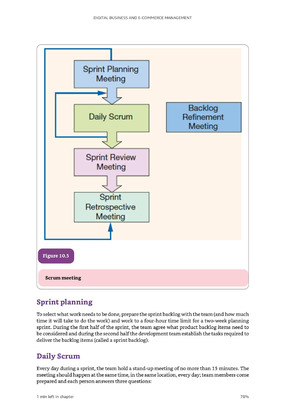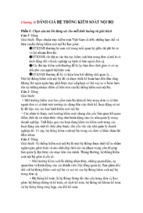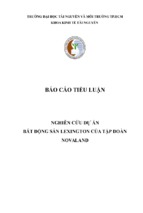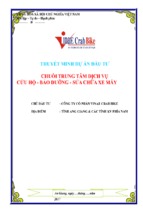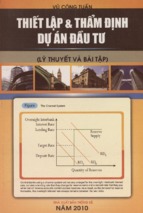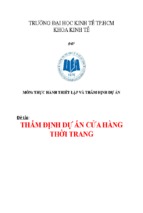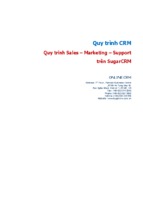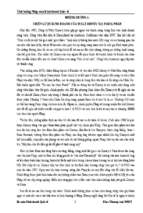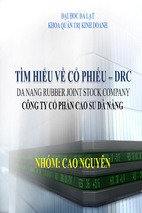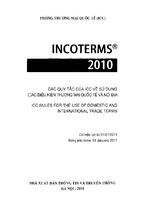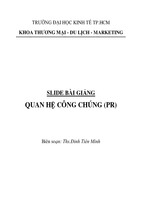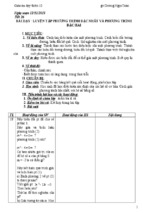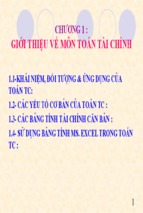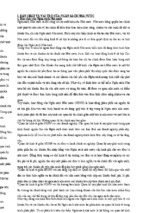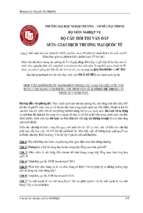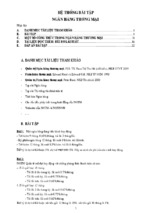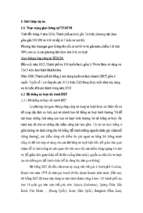tài liệu 7 loại lãng phí trong sản xuất
The 7 Forms of Waste
www.shmula.com
The Shmula.com Guide to
The 7 Forms of Waste
Page 1 of 25
By Pete Abilla
The 7 Forms of Waste
www.shmula.com
By Pete Abilla
Preface
This document, unlike other literature on the Toyota Production System or Lean
Thinking, explains the concept of “waste” in the form of examples – many examples. The author
finds that explanation through real-world examples is the most powerful way to teach and the
most effective means for students to learn. This approach also aligns with Taiichi Ohno’s maxim
of “practice over theory” – and that shall be our maxim also.
This document explains the concept of “waste”, shows waste in several real-world
examples, and provides some insight into how to identify and effectively reduce or eliminate
waste.
The intended audience for this document is as follows:
•
•
•
•
If you are a student learning the Toyota Production System or Lean
Manufacturing.
If you are a practitioner of Lean.
If you are a researcher in the fields of Operations Management, Supply Chain
Management, Logistics, and general business education.
If you are a graduate student in business school or in an MBA program where
learning about process improvement or continuous improvement is part of your
core studies.
I hope that you find this document helpful in your study of Lean.
Unless otherwise noted, Pete Abilla (www.shmula.com), is the author of the articles
below.
Enjoy and thank you for reading.
Pete Abilla
September 2010
Salt Lake City, Utah
http://www.shmula.com/
Page 2 of 25
The 7 Forms of Waste
www.shmula.com
By Pete Abilla
Introduction
Muda (無駄) is a traditional Japanese term which means “waste”. One way to increase
profitability of the firm is to fundamentally reduce costs. From a Lean perspective, this means to
reduce or eliminate wastes. Fundamentally reducing wastes means to be more profitable.
To properly understand waste, it is important to first clarify value and purpose.
Every process has a purpose. All the steps that lead to achieving that purpose are what
we consider “value”. All the steps that do not support the purpose of the process is waste.
The concept of Muda or Waste is a key lesson in the Toyota Production System. Shigeo
Shingo, the co-developer of the Toyota Production System observed the following:
“…only the last turn tightens the bolt. All previous turns is just motion.”1
Another way to describe waste is by categorizing our activities, like the following:
There are 3 types of activities, 2 of which produce waste:
A. Steps that definitely create value.
B. Steps that create no value, but are necessary given the current state of the system.
C. Steps that create no value and can be eliminated.
(B) & (C) naturally create waste, of which there are 7 types:
1. Overproduction: Producing more than is needed, faster than needed or before needed.
2. Waiting: Idle time that occurs when co-dependent events are not synchronized.
3. Transportation: Any material movement that does not directly support immediate
production.
4. Processing: Redundant effort (production or communication) which adds no value to
a product or service.
5. Inventory: Any supply in excess of process or demand requirements.
6. Motion: Any movement of people which does not contribute added value to the
product or service.
7. Defect: Repair or rework of a product or service to fulfill customer requirements.
One acronym that is helpful to remember the 7 Wastes is TIMWOOD.
1
A study of the Toyota Production System, http://tinyurl.com/269cvhh
Page 3 of 25
The 7 Forms of Waste
www.shmula.com
By Pete Abilla
In what follows, you’ll read real examples of waste from various industries, processes, and
fields in business. Specifically, you’ll read examples of wastes from the following:
•
•
•
•
•
•
•
•
•
7 Wastes in Software Engineering
7 Wastes in Medical Billing
7 Wastes in Product Development
7 Wastes in Paid Search Marketing
7 Wastes in Customer Service
7 Wastes in Affiliate Marketing
7 Wastes in Human Resources
7 Wastes and the Office
7 Wastes and the Environment
Suggested Reading:
•
•
•
•
•
•
•
•
•
Kaizen and the Art of Creative Thinking, Shigeo Shingo, http://amzn.to/9TSBJm
Understanding A3 Thinking: A Critical Component of PDCA, http://amzn.to/dpS9g4
Creating a Lean Culture, http://amzn.to/aETxnY
Managing to Learn: Using the A3 Management System, http://amzn.to/cTWDri
The Toyota Kata, http://amzn.to/diFW2w
The Toyota Way Fieldbook, http://amzn.to/bhpB4A
The Toyota Way, http://amzn.to/cKg4tb
Lean Thinking, http://amzn.to/dtxLu5
Learning to See: Value Stream Management, http://amzn.to/cS9PEf
Page 4 of 25
The 7 Forms of Waste
www.shmula.com
By Pete Abilla
7 Wastes of Software Engineering
Written by Pete Abilla
Transportation
•
Handoffs - Movement of product that does not add value.
Inventory
•
•
•
•
•
Requirements - Product Requirements Documents (PRD), Story Cards - more material
information than the customer needs
Completed code, but not checked-in
Completed code, but not documented
Untested code, Code in staging environment, but not in production environment
Code with overwhelming amount of comments /*comments*/
Motion
•
•
Task-Switching - Bodily or mental motion that does not add value
A evil-twin of Task-Switching is Multi-Tasking
Waiting
•
•
•
•
•
Delay - Idle time when people, material, information, or equipment is not ready
Waiting for project approval
Waiting for resources
Waiting for change approval process
Waiting for product management or requirements
Overprocessing
•
•
•
Extra Steps or Effort - effort that does not add value from the customer's perspective
Having to relearn what a function, class, or piece of code does
Having to refactor a piece of code when it already meets requirements
Overproduction
•
•
•
More Stuff - Producing more than the customer needs or wants
Featuritis or Feature Bloat: more features than the customer needs, wants, or asked for
Wrong Thing - Building something a customer doesn't want or does not use
Defects
•
Bugs - errors, rework, mistakes, or is missing something necessary
Page 5 of 25
The 7 Forms of Waste
www.shmula.com
By Pete Abilla
7 Wastes of Medical Billing2
Written by Devin Cabanilla
The bill processing and revenue stream in health care is particularly problematic,
complex and expensive. More than a decade ago, a New England Journal of Medicine3 article
estimated administrative costs of health care to be as much as $294 billion (Campbell, et al.), and
it has only increased since then.
The process begins when a patient makes an appointment and ends when a medical claim
is paid by the insurance company. Countless staff and departments contribute to the flow of
information and work to achieve payment for patient care provided. Every step in this lengthy
process has the potential for administrative waste: excessive paperwork, back-and-forth
interactions between provider and payor, nuanced contracts unique to each insurance company,
and different forms and ways each payor wants to exchange information. It’s not surprising the
hassle has led some doctors to refuse to accept certain forms of insurance payment at all.
Virginia Mason Medical Center’s Patient Financial Services has done extensive work to
evaluate the revenue stream and diligently remove waste from the system. Below are some of the
common revenue stream wastes in most medical settings today, and many which the Virginia
Mason team has helped reduce or eliminate through its continuous improvement work.
Transportation
Movement of product that does not add value
•
•
•
Using electronic clearinghouses to transmit medical claims to different insurance groups.
Faxing and mailing additional medical or insurance documentation between the patient,
payor and provider.
Mailing claims in paper format, using courier services.
Inventory
More material information than the customer needs
•
•
Claims held in data systems pending queue transmission.
Mail correspondence from insurance companies notifying or requesting information.
2
Written by Devin Cabanilla who conducts continuous improvement activities in insurance enrollment and billing
database areas at Virginia Mason Medical Center in Seattle. He applies the principles of Lean Management (Lean
Manufacturing) to his work in healthcare. Outside of work Devin enjoys BBQ, Starcraft, reading, and spending time
with his wife and two toddlers.
3
content.nejm.org/cgi/content/short/349/8/768
Page 6 of 25
The 7 Forms of Waste
•
www.shmula.com
By Pete Abilla
Specialized staff who only work with specific payors.
Motion
Bodily or mental motion that does not add value
•
•
Claims channeled through redundant layers of system edits and checks at the provider
source, clearinghouse and payor.
Emailing questions to multiple people with claim-specific or insurance-specific questions
Waiting
Idle time when people, material, information, or equipment is not ready
•
•
•
•
•
•
Waiting for forms, reviews, approvals and signatures.
Waiting for receipt of funds for claims aging beyond their original service date.
Waiting for payor review of a medical claim appeal.
Waiting for system upgrades and changes to be implemented due to new medical
procedures.
Waiting for payors to amend or update payment routines for the patient or provider based
on pending contract renewals.
Waiting on hold for customer services to obtain insurance information
Overprocessing
Effort that does not add value from the customer’s perspective
•
•
•
•
•
Checking the claim status for every patient balance outstanding via phone, mail and
internet portal.
Receiving overpayment/underpayment, reprocessing the bill and re-pricing claim
information for the payor.
Sending a claim multiple times when no response is received from the payor.
New medical procedure codes, retesting software and claim checks.
Asking the patient for existing information: insurance cards, address, relatives.
Overproduction
Producing more than the customer needs or wants
•
•
•
Generating multiple invoices/statements for the patient’s health care services.
Creating duplicate files in multiple folders within workstations and filing cabinets.
Recoupment efforts on low balance claims (e.g. $2 lab fees, $7 diagnostics).
Page 7 of 25
The 7 Forms of Waste
www.shmula.com
By Pete Abilla
Defects
•
•
•
•
•
Billing complaints for any reason from a patient are indicative of a defect.
System errors, such as corrupted data, miscoded system logic, data stream interruptions,
create claim denials or halt flow.
Transcription errors where clinical information was not input correctly resulting in denial.
Registration errors when inaccurate demographic information was not received from the
patient resulting in denial.
Unauthorized procedures, such as surgeries, procedures or inpatient stays requiring
authorization with the insurance company prior or during medical services, or denial will
occur.
Page 8 of 25
The 7 Forms of Waste
www.shmula.com
By Pete Abilla
The 7 Wastes of Product Development
Written by Tim McMahon
4
The first step in eliminating waste from New Product Development (NPD), and thus
improving the process, is to learn to identify the eight wastes. By closely examining the entire
NPD process from a Lean perspective, the opportunities to drive out waste and increase value
will become obvious.
Defects
Defects are the result of executed processes that did not produce value.
•
•
•
•
•
Improper information on drawing
Missing views on drawing
Incomplete information
Product flaws resulting in missing customer expectations
Reworking product or processes
Overproduction
Waste from producing product that is not currently needed or product that is not needed at all.
•
•
•
Unnecessary documentation
Cost overruns due to excessive project time charging
Overlap of strategic and non-strategic projects competing for limited resources
4
Written by Tim McMahon. You can connect with on his blog – leanjourneytruenorth.blogspot.com. Tim
McMahon is the Founder and Contributor of A Lean Journey Blog. This site is dedicated to sharing lessons and
experiences along the Lean Journey in the Quest for True North. The blog also serves as the source for learning and
reflection which are critical elements in Lean Thinking.
Tim is a lean practitioner with more than 10 years of Lean manufacturing experience. He currently leads continuous
improvement efforts for a high tech manufacturer. Tim teaches problem solving skills, lean countermeasures, and
how to see opportunities for improvement by actively learning, thinking and being engaged.
Tim McMahon has been supporting the AME Northeast Region Board of Directors as the Social Media Lead. His
role is to identify how to best leverage social media tools for increasing networking within AME's Northeast Region.
Social media tools include LinkedIn, Twitter, Slideshare, YouTube, Facebook, etc. Tim also works together with
others on AME's Social Media Council to build AMEConnect, a members-only online networking site, and presence
and content on the other Social Media sites.
Page 9 of 25
The 7 Forms of Waste
www.shmula.com
By Pete Abilla
Waiting
No value is added while people wait for product to process or product waits for people or
machines.
•
•
•
Unbalanced workflow within the team
Time spent getting approvals
Dependant on the number of hand offs and task dependencies
Non-utilized resources/talent
The waste of underutilized intelligence and intellect commonly referred to as behavioral waste.
•
•
Underutilizing people’s knowledge and creativity
Uneven work flow resulting with some team members overburdened while other
underutilized
Transportation
While the product is moving, no value is added to it.
•
•
Carrying, mailing, or even e-mailing documents stops the process
In an electronic system look at the number of hand offs where we pass something to
someone else
Inventory
Inventory is the collection of unprocessed documents, data objects, and transactions queued-up
between people and processes.
•
•
Drawings and specification - we invest time to make them, update them, and manage
them
Collections of unprocessed information and data
Motion
Excess movement by people or equipment only consumes time and resources without producing
value.
•
•
Efficiency of software – number of mouse clicks, number of routines, number of
transactions
Frequently searching for drawings and other information on remote shared services like
servers or printers
Page 10 of 25
The 7 Forms of Waste
www.shmula.com
By Pete Abilla
Excess Processing
Doing more than what is necessary to generate satisfactory value as defined by the customer.
•
•
•
•
•
Using software that has a function beyond what is needed
Product designs or processes that are too complex
Unnecessary steps in design process
Excessive number of iterations
Over-designed or over-engineered product
The acronym I prefer for remembering the eight wastes is DOWNTIME since it symbolizes
lost opportunity. Another one that works well for NPD is TOWISDOM where S is skills. NPD
is one essential element in the growth strategy that is so critical in all companies practicing Lean
Thinking.
What examples of waste have you seen in your NPD process? How do you address the
concerns, fears, uncertainties and misconceptions regarding Lean as it applies to NPD?
Have you heard any of these myths before?
•
•
•
•
•
•
•
“Lean only applies to the factory. It won’t work in my area.”
“We can’t apply Lean to NPD because what we do is not repetitive.”
“Product Design is creative, based on discovery and innovation; Lean will remove all
creativity by forcing us to work to standards.”
“Lean works well only on linear processes. Product Development is project-based and
has multiple parallel processes and task dependencies. Lean is simplistic”
“Every task is executed differently on every project; you can’t implement standardized
work on projects.”
“There is no ‘Gemba’ (visible production area) in product development because design
teams are not co-located and much of the work is subcontracted.”
“Customer demand and Takt time are not relevant because there is no customer; we work
to the project deadline.”
Page 11 of 25
The 7 Forms of Waste
www.shmula.com
By Pete Abilla
The 7 Wastes of Paid Search Marketing
Written by Matt LeVeque
5
I’VE BEEN WORKING in the Search Engine Marketing industry for a while in various
capacities and have spent the last 3 years working in an agency setting managing multiple Paid
Search accounts. During this time I have come to learn that there is a significant amount of waste
that goes into managing these accounts. Waste in Paid Search comes in many forms such as
reorganizing campaigns and ad groups, waiting for 3rd party analytics software to work (and
work properly), fixing of broken URLs and the list goes on.
Waste in this industry, and any industry for that matter, is considered non-value added
work that your company or your client is not willing to pay for. At Toyota Taiichi Ohno, one of
the founding fathers of the Toyota Way, lean management system and the Toyota Production
System, described the 7 Wastes of Production as “all activity that adds cost but not value”.
For all intents and purposes, even though Search Engine Marketing may be perceived as
a service, the reality is that what goes on behind the scenes is more like a manufacturing
operation. We build Paid Search marketing campaigns, some times from scratch, that consist of
various components just like manufacturing a product. Search marketers design and build these
campaigns in order to serve ads when the end user requires them – very similar to the pull system
used in lean manufacturing and at Toyota.
This comparison might seem way off base for anyone not familiar with lean or new to
Paid Search so let’s get to the subject of this article and talk about the 7 Wastes of Production
and how they relate to the life of Paid Search Marketer.
5
By Matt LeVeque has over 10 years of website management and online marketing experience. He is currently
working as the Sr. Manager, Search Marketing & Quality Services with ClickEquations, the industry leader in
software-based search marketing that improves paid search campaign performance through intelligent
automation. Matt Leveque is a Google AdWords Qualified Individual, a Microsoft adExcellence Member and a
thought leader in quality search engine marketing topics.
His view of search engine marketing is heavily influenced by quality principles, systems thinking and sustainable
practices.
Prior to his position at ClickEquations Matt was the Sales & Online Marketing Manager for Rath & Strong
Management Consultants, the leading global provider of Lean, Six Sigma, Lean Six Sigma and Organizational
Development consulting & training. He is currently an active Senior Member of the American Society for Quality
(ASQ), the Sustainable Business Network of Greater Philadelphia and the Information Architecture Institute. Matt’s
extended professional profile can be found at LinkedIn. Matt publishes his writings at senscience.com/sem-blog.
Page 12 of 25
The 7 Forms of Waste
www.shmula.com
By Pete Abilla
Overproduction
Producing more than the customer needs right now.
This can be related to things like duplicate keywords across multiple ad groups, too many ad
creatives that make testing irrelevant or bidding on the same keyword with multiple match types
at the same bid.
Waiting
Idle time created when material, information, people, or equipment is not ready.
This one is my favorite because to me it’s the biggest contributor to waste. In this case idle time
spent while waiting for 3rd party analytics tools to load or refresh and do so properly is #1 on my
list. Other contributors to waiting are things like waiting for days until your agency rep calls you
back, waiting for your client to make decisions and waiting for colleagues to review client
deliverables. Recently Google AdWords has taken notice of the waste of waiting and will now
dock you Quailty Score points for destination landing page load time.
Inventory
More materials, parts, or products on hand than the customer needs right now.
This is similar the ‘too much too soon’ or ‘big bang effect’ of building out a new Paid Search
account with more campaigns and stuffing the ad groups with 1,000’s of keywords – much more
than necessary. Work in progress is related to the waste of inventory as well. Another form of
inventory related waste as it relates to fair competition is the double and triple serving of ads that
some companies and agencies get away with.
Motion
Movement of people that does not add value.
Okay so we are not moving people, but in ’service’ related industries, the waste of motion
includes things like searching your desktop or file folders for that excel file you used two months
ago. Using multiple tabs in a web browser or having to take multiple steps in UI to make one
small change is waste of motion. Throwing nerf-darts at your co-works is a HUGE waste of
motion, but a hell of a lot of fun.
Defects
Work that contains errors, rework, mistakes or lacks something necessary.
This is another big one. Inheriting a Paid Search account from another agency or in-house
operation always requires rework. Reorganization of campaigns in a way that is logical so that is
Page 13 of 25
The 7 Forms of Waste
www.shmula.com
By Pete Abilla
both cost efficient and effective toward growth can take months depending on the size of the
account. Other Paid Search defects include broken destination URLs, landing page offers that do
not match the ad creative, ad creatives that do not match search queries and keywords that are
simply too broad to be effectively targeted.
Overprocessing
Effort that adds no value from the customer’s viewpoint.
Overprocessing can almost always be attributed to extra steps added to manual work. Building
Paid Search campaigns with multiple ad groups and keywords is a very manual process and so is
most reporting on the success of these efforts. There are automated (see Pay-Per-Click
Autonomation) ways to improve the waste of over processing.
Another example of over processing in Paid Search or any similar marketing channel is not fully
understanding client/user requirements or expectations. For example if a 3rd party analytics tool
can have all the bells and whistles and even tell you the color shirt a user was wearing when a
purchase was made but cannot make the simple export function work properly, the analytics
development team produced more than was required by the Paid Search Marketer.
Transportation
Movement of product that does not add value.
This one is a little tricky for Paid Search. One example would be trying to build out a Yahoo
Search Marketing account from scratch by trying to import the existing Google AdWords
account. Because of editorial differences between the two platforms there can be a significant
amount of waste in moving one campaign structure to another.
Hopefully this clarifies the similarities of shop-floor production to cube-wall production and
sheds some light on the types of waste to be aware of when taking on the responsibilities of a
Paid Search Marketer.
Page 14 of 25
The 7 Forms of Waste
www.shmula.com
By Pete Abilla
The 7 Wastes of Contact Centers
Written by Pete Abilla
I recently bought a Dishwasher from Sears. My experience was terrible – numerous
calls to customer service and a field operations team that wasn’t friendly to the customer.
Here’s a timeline of my experience:
That experience exposed a lot of waste in customer service operations, some of which I
highlight below:
Transportation
Movement of product that does not add value
•
[see Motion].
Inventory
More material information than the customer needs
Page 15 of 25
The 7 Forms of Waste
•
www.shmula.com
By Pete Abilla
Abandonment Rate is a measure of how many customers are not willing to wait. The
number of customers waiting can be considered inventory. The goal is zero inventory or some manageable level based on workforce.
Motion
Bodily or mental motion that does not add value
•
Who enjoys being transferred from one customer service agent to another, to another, to
another, to another? This unnecessary motion just adds to wait time, burden on the
customer, and potentially loss of business or poor satisfaction.
Waiting
Idle time when people, material, information, or equipment is not ready
•
•
Waiting for anything - people, paper, machines, the FAX machine, copier, information.
Waiting for a customer service agent.
Overprocessing
Effort that does not add value from the customer's perspective
•
In my Sears poor customer experience, I was asked for my phone number, name, and
address - 6 TIMES.
Overproduction
Producing more than the customer needs or wants
•
•
No, I'm not interested in your other services or products. Don't peddle merchandise to me
- just please solve my problem.
I know customer service agents have a hard job - they are often the messengers getting
blamed for the problems of the company. That's not fair. But, one type of
overproduction is when the agent tells the customer how hard of a day he's had - the
customer doesn't need to know you've had a hard day. Just please try to resolve the
customer's problem.
Defects
•
•
The reason why I'm calling in the first place - service wasn't done right the first time. In
my case, it wasnt' done right the second time, third time either.
As a customer, being treated nice and respectfully is expected; when not, that's a defect.
Page 16 of 25
The 7 Forms of Waste
www.shmula.com
By Pete Abilla
The 7 Wastes of Affiliate Marketing
Written by Porter Haney6
Affiliate marketing7 is an efficient internet marketing channel that monetizes web traffic
through a revenue share. This relationship typically exists between e-commerce merchants and
content sites, with a merchant paying a percent of sales generated by a specific site.
In principle this arrangement is relatively simple. In practice affiliate marketing8 has become a
complicated process of affiliates, merchants, and affiliate networks built to facilitate these
relationships. Many of these systems can add undue wastes to an otherwise simple process. I'll
highlight a few of these wastes and where one might be able to improve.
Transportation
Movement of product that does not add value
•
The movement of ad creatives and feeds between multiple affiliate networks. Do you
need more than one affiliate network? Can you post all creative assets in one place?
Inventory
More material information than the customer needs
•
•
The number of affiliate or merchant relationships maintained. Are they active? Are they
producing? Are they representing your brand well?
The type and number of ad creatives maintained. Is anyone using them? Are they
converting? Do you have IAB standard sizes?
6
Porter Haney currently oversees online marketing at SwarmBuilder.com and publishes mountain adventure articles
at FamousInternetSkiers.com. He's been involved with web marketing at Backcountry.com, Atomic Skis, and The
Mount Washington Observatory.
7
Affiliate marketing is a marketing practice in which a business rewards one or more affiliates for each visitor or
customer brought about by the affiliate's marketing efforts. Examples include rewards sites, where users are
rewarded with cash or gifts, for the completion of an offer, and the referral of others to the site. The industry has
four core players: the merchant (also known as 'retailer' or 'brand'), the network, the publisher (also known as 'the
affiliate') and the customer. The market has grown in complexity to warrant a secondary tier of players, including
affiliate management agencies, super-affiliates and specialized third parties vendors. Affiliate marketing overlaps
with other Internet marketing methods to some degree, because affiliates often use regular advertising methods.
Those methods include organic search engine optimization, paid search engine marketing, e-mail marketing, and in
some sense display advertising. On the other hand, affiliates sometimes use less orthodox techniques, such as
publishing reviews of products or services offered by a partner. Affiliate marketing—using one website to drive
traffic to another—is a form of online marketing, which is frequently overlooked by advertisers. While search
engines, e-mail, and website syndication capture much of the attention of online retailers, affiliate marketing carries
a much lower profile. Still, affiliates continue to play a significant role in e-retailers' marketing strategies
(wikipedia).
8
Affiliate programs include, Commission Junction, share-a-sale, clickbank, and other best affiliate programs, top
rated affiliate programs.
Page 17 of 25
The 7 Forms of Waste
•
www.shmula.com
By Pete Abilla
The number of landing pages maintained. Do they match ad creatives? Could you get by
with fewer landing pages?
Motion
Bodily or mental motion that does not add value
•
•
•
Switching between tasks: creative maintenance, commission audits, affiliate
communications, internal reporting, tracking metrics, optimizing landing pages. Can you
organize better?
Searching reports for missing data: sales, creatives, affiliates, conversions.
Searching feeds for missing information: products, descriptions, prices.
Waiting
Idle time when people, material, information, or equipment is not ready
•
•
•
Delays in communications with affiliates. Delays in affiliates pushing promotions live.
Can you incent faster behavior?
Waiting for web analytics software, affiliate network software.
Waiting for new ad creatives, promotion events.
Overprocessing
Effort that does not add value from the customer's perspective
•
•
•
Merging network and analytic data. Do you need specifics, or just trends?
Paying manual incentives to affiliates. Can you automate?
Digging too deep into a specific affiliate or merchants problem or program.
Overproduction
Producing more than the customer needs or wants
•
Too many ad creatives, affiliates, merchants, reports, metrics, affiliate networks. Are you
spending too much time in any of these categories?
Defects
•
•
Errors in commissions, product feeds, internal / external reporting.
Discrepancies ad creatives and landing pages.
Page 18 of 25
The 7 Forms of Waste
www.shmula.com
By Pete Abilla
The 7 Wastes of Human Resources
Written by Jim Baran9
Lean is a people system. Its design is business continuous improvement and respect for
people every minute of every day. If this is true, my watch stopped 15 years ago.
I’ve worked in and with human resources for the past 30 years. The last 15 years
providing talent to hundreds of lean inspired companies. Regarding people processes it seems as
if nothing has changed. The people processes in existence before lean have not changed because
of lean.
The goal of lean is to provide products and services to customers without nonsense and
waste. The assumption that all human business is somehow HR business is mistaken.
The reality is HR and lean organizations share in the consequences of a disengaged
workforce. It is nonsense that these two factions rarely connect, collaborate, or participate
together purposefully in the lean process. This disconnection creates knowledge resource waste.
Instead of purpose and credibility, the workforce sees special effects. Respect teeters daily.
Overproduction: Overproduction is waste defined as producing work or providing a service
prior to it being required or requested.
•
•
Perhaps, overproduction in the human business of lean is best portrayed as over
enthusiasm. To quickly get our arms around lean, we’ve built separate lean departments
to coexist beside established HR departments. Each is independently managed.
Common purpose is difficult to ascertain.
The problem with HR & lean not joined collectively is this: both exist because of people.
Both produce to, not for people, at different speeds, different directions, and with
9
Jim Baran owns Value Stream Leadership. Jim has been a student of lean since 1985. VSL’s work includes: hiring
lean inspired talent and helping companies better connect their existing talent so all interact and participate daily in
the lean process.
Jim’s background includes many years in manufacturing human resources leadership and talent project
management. He connects with life through family and fly-fishing.
•
•
•
•
•
•
•
VSL Website: http://www.valuestreamleaders.com/
Blog RSS feed: http://www.valuestreamleaders.com/index.php/blog/rss_2.0/
The Lean Career Compass: http://bit.ly/311Aep
LeanBlog Podcast #88 – Jim Baran on Lean Talent Management http://lnbg.us/1CH
Twitter: @LEANVSL & @leancraftsman
LinkedIn: http://bit.ly/12UT21
Facebook Fan Page: http://bit.ly/bAF4nR
Page 19 of 25
The 7 Forms of Waste
•
www.shmula.com
By Pete Abilla
different expectations. Lean measures human performance with value creating rules and
tools; HR measures human defects with complex ever changing laws. Skill development
is overshadowed by justifications.
These disjointed mindsets are often interpreted by internal customers more with “if then”
uncertainty than sustained value. Tribal customs remain in constant motion and conflict
with expected and ideal lean transformation performance standards. Messy.
Waiting: What are we waiting for?
•
•
What’s keeping HR and Lean from joining together to work on the human business of
lean? Are we waiting for contract signatures to tell us we must work together to
accomplish greater good?
Some lean inspired HR folks I’ve spoken with embrace and engage in lean activities
often – not because they have to, but because they understand value is in the action. Lean
thinkers seem to enjoy and spend much time “turning the lights on” in knowledge
workers heads but almost no time in the heads of people who work with people
knowledge daily. For years we’ve tried connecting HR & Lean through osmosis. The
time to self-initiate is now. Any step closer to close the gap between these two groups is
incremental improvement.
Motion: If HR is more about recognizing flaws as to comply with laws, then people will often
go through the motions to comply. Motions are not processes. If visible processes are
constructed between HR and Lean then they can began to interact with each other daily and start
learning from each other. We don’t need a judge to grant joint custody of the human assets
inside a lean learning organization.
Transportation or conveyance: There are usually no planned routes connecting lean knowledge
and learning between the various people systems and processes lean learners travel.
•
•
•
It’s my experience lean is interpreted and practiced differently at every company. It’s
supposed to be different because people, not plaques or certificates perform the work.
HR and Lean practitioners both depend on external sources to certify their knowledge
credibility. HR utilizes the Society of Human Resources Management (SHRM); Lean has
assorted choices. All are portable. A few years ago, companies started certifying their
workforces to measure lean learning and application progress (bronze, silver, chartreuse,
etc.). Unfortunately, workforce certification is limited to the company you’re currently
working for.
What collective knowledge transfers to those performing the work? Who earns more
money, those certifying or those performing the work? Since both HR and lean share
responsibility for a disengaged workforce, and lean knows no boundaries, does it not
make more sense to have one collective body of knowledge than several?
Page 20 of 25
- Xem thêm -

